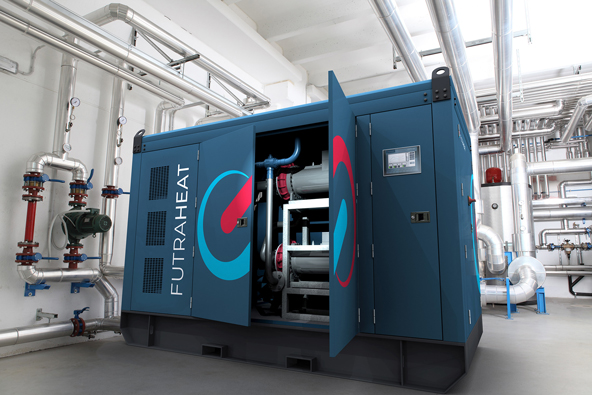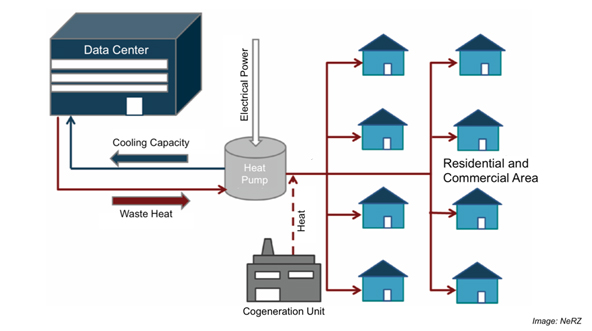
The push against climate change is real and urgent, leading us to rethink how we design our buildings. More and more, we're seeing the move towards buildings powered entirely by electricity as a solid step in cutting down our carbon footprint.
Heat pumps are at the forefront of this change because they move heat rather than produce it by burning fuels, marking a significant leap in our approach to sustainable heating and cooling. This method is smarter, cleaner, and a vital part of our transition to a future where buildings contribute to solving the climate crisis, not adding to it.
However, there's a significant catch with heat pump technology that's an industry-wide challenge. As efficient as heat pumps are, their performance starts to falter when faced with high Delta T – the difference between the heat source and heat sink temperatures. ENERVEX offers novel Waste Heat Recovery Systems (WHRS) that can mitigate heat pump inefficiencies to help you overcome this inefficiency gap.
Traditional gas and oil boilers contribute significantly to CO2 emissions. Burning fossil fuels for heating is not sustainable in the long term, given the urgent need to reduce greenhouse gas emissions and limit global warming. Combustion in boilers can also release pollutants such as nitrogen oxides (NOx) and particulate matter, contributing to air pollution and posing health risks to urban populations.
The move towards phasing out gas boilers is gaining momentum globally. The UK government has banned the installation of gas boilers in new homes by 2025 as part of its broader net-zero emissions goal. Many major US cities like Seattle and New York City have also banned this type of boiler in new construction – pushing instead for more sustainable solutions.

Electric boilers offer a cleaner alternative to their gas counterparts and boast impressive efficiency rates – transferring 100% of electrical energy into heat without any loss.
However, the deployment of electric boilers, especially those with a large BTU capacity for commercial or industrial applications, requires electrical infrastructure that can support massive amperages. In such scenarios, heat pumps are usually a more viable solution, capitalizing on their ability to transfer heat rather than generate it, which results in lower electrical demands and improved energy efficiency.
Heat pumps operate on the principle of the refrigeration cycle, utilizing the thermodynamic process of compressing and expanding a refrigerant fluid to transfer heat against its natural direction of flow. This process allows for the extraction of heat from a lower temperature source and its subsequent release into a higher temperature sink, or the reverse, depending on heating or cooling needs.
The capability to either absorb heat from a cooler environment and release it into a warmer one or vice versa makes heat pumps an energy-efficient alternative to traditional heating and cooling systems that generate heat through combustion.
When considering the implementation of heat pump systems, several factors come into play:

Heat pumps can be broadly classified into three categories based on their heat source and sink interactions:
While air-based systems have been traditionally popular, water-to-water heat pumps are gaining traction, especially in fully electric commercial buildings, hotels, and hospitals.
One of the primary limitations of air-to-air heat pumps is their dependency on external air temperatures. Their efficiency decreases as the outside temperature drops, making them less effective in extremely cold climates.
Air-to-air heat pumps also require outdoor and indoor units to function. The outdoor unit can be large and may not be aesthetically pleasing, which can be a significant consideration for residential properties or historical buildings.
Water-to-water heat pumps extract heat through a hydronic or waterside evaporator system and subsequently discharge it via the condenser to the other side.
The process is highly dependent on the temperature gradient (delta T) between the heat source and the heat sink, with an optimal delta T of ~20°F. With an optimal temperature gradient, the heat pump can operate without exerting excessive energy to compress the refrigerant yet is sufficient to allow a meaningful amount of heat to be transferred from the source to the sink.
Water-to-water heat pumps are increasingly favored for waste heat recovery for several reasons:
Water-to-water heat pumps are celebrated for their ability to transfer heat efficiently under optimal conditions. However, their performance faces a notable decline when operating across high-temperature differentials between the heat source and sink.
The core of the issue lies in the pump's coefficient of performance (COP), a metric gauging efficiency, which experiences a drop as the required delta T rises. This inverse relationship stems from the increased mechanical effort and energy expenditure demanded of the compressor to sustain a larger temperature gradient conducive to heat exchange
As the temperature differential increases, the compressor is compelled to exert more effort in boosting the refrigerant's pressure and temperature to a point where efficient heat transfer with the target medium is possible. This heightened demand on the compressor not only escalates energy consumption but also drives up operational costs while reducing the energy efficiency ratio— the amount of energy output for every unit of input. Consequently, the overall efficiency of the system takes a hit. The drop in efficiency is especially significant in scenarios that demand high output temperatures, such as certain industrial operations or in areas subjected to harsh climatic conditions.
This issue with high delta T is not merely theoretical but represents a practical barrier to the broader adoption and application of water-to-water heat pump technology.
Incorporating waste heat recovery systems into water-to-water heat pumps offers a compelling strategy to overcome their efficiency challenges at high delta T. This approach utilizes waste heat as an auxiliary heat source that serves to preheat or precool the refrigerant before it enters the compressor, effectively reducing the workload on the compressor.
As a result, the compressor operates more efficiently, consuming less energy to achieve the desired temperature gradient. This improvement directly translates to a higher coefficient of performance (COP). When WHR systems and heat pump installations are combined, heating and cooling efficiency can be maximized.
Waste Heat Recovery can also be utilized across a variety of industries, wherever there is excess heat that can be captured and repurposed. Some notable examples include:

The use of insulated storage tanks in waste heat recovery systems can be used to manage the imbalance between heating demands and the availability of waste heat. The recovered heat can fluctuate in availability and temperature, not always aligning with the immediate heating needs of the facility. Insulated storage tanks allow for the temporary storage of this upgraded heat, ensuring that it can be retained efficiently until needed.
The stored heat can then be drawn upon as needed, effectively decoupling the generation of waste heat from its utilization. This enables a more flexible and reliable supply of heat, improving the overall efficiency of the heating system and reducing reliance on primary energy sources.
ENERVEX's Waste Heat Recovery System (WHRS) leverages the recovery and utilization of waste heat from industrial processes, such as boiler flue gases, oven exhaust, or other high-temperature waste streams to tackle the challenges faced by heat pumps operating at high delta T. By integrating a waste heat recovery system with heat pump installations, ENERVEX can augment the heat source temperature, thus reducing the delta T required for the heat pump to achieve the desired output temperature. This maximizes efficiency while minimizing energy consumption and carbon emissions of your facilities.

With its fan-powered flue gas economizer featuring integrated bypass and modulating pressure control, the system can simultaneously capture waste heat from multiple sources, guaranteeing optimal use of your available thermal energy. This modular hybrid micro-channel/plate heat exchanger design is compact and generates significant energy savings compared to traditional economizers.
The WHW system can supply hot water for various applications, including process water, building heating, and Waste Heat to Power (WHP) systems.
Consider investing in ENERVEX's Waste Heat Recovery Solutions to gain access to exceptional performance and energy savings, with a rapid payback period typically less than two years.